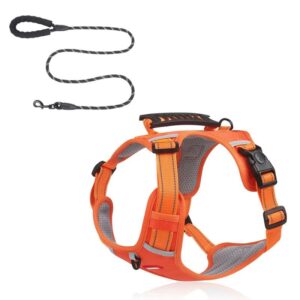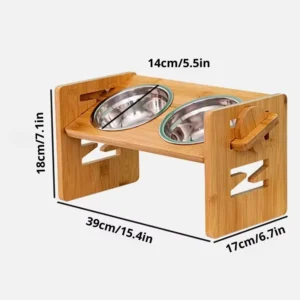Hip Dysplasia in French Bulldogs: What Owners Should Know

If you own a Frenchie, you know how these dogs love to zoom around and play. But what happens when your playful pup starts showing signs of discomfort? One common joint problem in French Bulldogs is hip dysplasia. In this blog post, we’ll explore what hip dysplasia in French Bulldogs is, how to recognize it, and what you can do to help your furry friend.
French Bulldogs love playtime, but if you notice your pup limping or “bunny hopping” during play, it could be a sign of hip dysplasia. This condition can really slow down an otherwise energetic dog.
What Is Hip Dysplasia in French Bulldogs?
Hip dysplasia is a fancy term for a hip joint that does not form correctly. In a healthy dog, the hip joint works like a “ball and socket” – the ball (top of the thigh bone) fits snugly into the socket (hip bone).
In French Bulldog hip dysplasia, the ball and socket don’t fit together properly. Instead of a smooth rotation, there’s grinding and instability. Over time, this can cause pain and arthritis in the joint.
French Bulldogs aren’t a large breed (hip dysplasia is often talked about in big dogs like German Shepherds, Belgian Malinois, or Labs), but Frenchies can absolutely get hip dysplasia. In fact, bulldog breeds in general have their share of orthopedic issues. The condition might be present from a young age (due to genetics) or develop as your dog gets older. It’s one of several joint problems in French Bulldogs that owners should be aware of.
Common Signs and Symptoms of Hip Dysplasia
How do you know if your Frenchie might have hip dysplasia? Here are some common signs and symptoms to watch for:
- Limping or Lameness in the Hind Legs: You may notice your Frenchie favoring one hind leg or alternating legs, especially after exercise.
- “Bunny Hopping” Gait: This is when a dog runs or climbs stairs by using both back legs together in a hopping motion, rather than a normal stride.
- Stiffness and Difficulty Moving: Your dog may have trouble getting up from lying down, or seem stiff and sore, especially in the morning or after naps.
- Reduced Activity or Playfulness: A Frenchie with hip pain might tire easily, resist long walks, or not be as playful because it hurts to move around.
- Difficulty Climbing Stairs or Jumping: If your pup suddenly refuses to jump onto the couch or struggles with stairs (when they used to handle it fine), hip issues could be a cause.
- Swaying or Wobbly Walk: Some dogs develop a swaying “duck waddle” walk as they try to compensate for loose hips.
- Pain or Sensitivity: Your Frenchie may yelp or become protective if you touch their hips or lower back. They might also sit in a “frog-leg” position (hind legs splayed out) more often because it’s comfortable for them.
Causes of Hip Dysplasia in French Bulldogs
Hip dysplasia is usually caused by a mix of genetics and environment. Here are the main factors that can lead to hip dysplasia in French Bulldogs:
Genetics and Breeding Practices
The tendency for hip dysplasia can be passed down from a dog’s parents. If a French Bulldog’s mom or dad had poor hip joints, there’s a higher chance the puppy will have hip issues too. Reputable breeders try to screen for hip dysplasia in French Bulldogs and other hereditary problems.
Unfortunately, not all breeders are careful, and irresponsible breeding can spread this condition. This is why it’s important to get Frenchie puppies from responsible breeders who test their dogs’ hips. Good breeding practices can reduce (but not eliminate) the genetic risk.
Weight and Exercise
Weight plays a big role in joint health. French Bulldogs love treats and can become overweight easily if we’re not careful. Extra weight puts more stress on those hip joints. A chubby Frenchie is more likely to develop hip dysplasia or make an existing condition worse.
On the flip side, over-exercising a young Frenchie (especially on hard surfaces or with a lot of jumping) might contribute to joint problems. Their bones are still developing when they’re puppies. Moderate, regular exercise is best – too little can lead to weak muscles that don’t support the hip, and too much can cause injuries.
(Tip: Wondering what a healthy weight is for a Frenchie? Check out our guide on ideal French Bulldog weight to keep your pup fit and take pressure off their joints.)
Growth and Development
Sometimes, even a well-bred, fit Frenchie can get hip dysplasia just from the way they grew. If the hip joint grows unevenly or the muscles around the hips don’t develop properly, the ball and socket can loosen.
This often happens when genetics and environment intersect – for example, a genetically susceptible puppy who grows too quickly or doesn’t get the right nutrients might end up with hip dysplasia. That’s one reason balanced puppy nutrition is important for dog hip dysplasia prevention across all breeds.
Hip Dysplasia vs. Other Joint and Spine Problems in French Bulldogs
Frenchies are unfortunately prone to a few different orthopedic issues. It can be tricky to tell what’s causing your dog’s mobility problem. Two big ones to know are hip dysplasia (our main topic here) and IVDD in French Bulldogs, which is a spinal issue.
Intervertebral Disc Disease (IVDD) is a condition where the discs in the spine bulge or herniate, pressing on the spinal cord. IVDD is one of the more common spine problems in French Bulldogs due to their short, compact build.
Symptoms can sometimes look similar to hip dysplasia: reluctance to move, weakness in back legs, or pain. However, IVDD is a back problem, not a hip problem. A Frenchie with IVDD might have a very tense belly, cry out when picked up, or even drag their hind toes. Hip dysplasia, on the other hand, is localized to the hip joints and doesn’t usually cause nerve pain or neck issues that IVDD can cause.
It’s also worth mentioning patellar luxation (kneecap dislocation) – a common joint problem in French Bulldogs where the kneecap slips out of place, causing limping similar to hip dysplasia. And as Frenchies age, arthritis can set in any joint. Because the signs overlap, a vet exam is crucial to pin down the exact issue. In some cases, a Frenchie could have more than one problem.
Diagnosing Hip Dysplasia in French Bulldogs: Vet Visits and What to Expect
If you suspect hip dysplasia in your French Bulldog, it’s time to visit the vet. Here’s what typically happens during a diagnosis process:
-
Physical Examination:
The vet will observe how your Frenchie stands, walks, and sits. They may gently manipulate your dog’s hind legs to test the range of motion in the hips and check for pain or looseness. Frenchies with hip dysplasia might have reduced range or discomfort when the vet extends their hind legs backward.
-
Discussion of History:
Be ready to share when you first noticed symptoms like limping or stiffness, and whether it’s getting worse. Mention if your dog has trouble with stairs or if there were any injuries. This history helps differentiate hip dysplasia from other issues.
-
X-Rays (Radiographs):
The gold standard for diagnosing hip dysplasia is an x-ray of the hips. Your vet will likely sedate your Frenchie (to keep them still and comfortable) and take x-ray images of the hip joints. The x-ray lets the vet see how well the ball and socket are aligned, if there’s any arthritis, and how severe the dysplasia is. Sometimes both hips are affected, sometimes just one.
-
Additional Tests:
In some cases, the vet might also x-ray the spine or knees to check for IVDD or knee problems if the symptoms are confusing. But usually, for a straightforward young Frenchie with typical signs, hip x-rays are enough to confirm dysplasia.
-
Veterinary Assessment:
After the exam and imaging, the vet will grade the hip dysplasia (mild, moderate, or severe) and discuss what that means for your dog. They’ll rule out other causes and then talk to you about treatment options.
Treatment Options for Hip Dysplasia in French Bulldogs
Treatment for dog hip dysplasia (and Frenchies specifically) can range from conservative home care to surgical intervention. The right approach depends on how severe your Frenchie’s hip dysplasia is and how much it’s affecting their life. It often starts conservative and only moves to surgery if needed. Let’s break down the options:
Conservative Management (Non-Surgical Options)
For many French Bulldogs with mild to moderate hip dysplasia, conservative management can keep them comfortable. This includes:
-
Weight Management:
As mentioned, keeping your Frenchie at a healthy weight is critical. If your pup is carrying extra pounds, your vet will likely prescribe a weight loss plan. Even a small reduction in weight can significantly lessen the strain on your dog’s hips.
-
Exercise and Physical Therapy:
Controlled, low-impact exercise helps maintain muscle tone which supports the hip joint. Short, regular walks are better than long, exhausting ones. Some vets also recommend physical therapy such as hydrotherapy (underwater treadmill or swimming) – the water’s buoyancy allows exercise without stressing the joints.
-
Pain Medication:
Vets often prescribe NSAIDs (non-steroidal anti-inflammatory drugs) or other pain relievers for dogs with hip dysplasia. These medications reduce pain and inflammation in the joint. Always use these under veterinary guidance and monitoring, as they can have side effects with long-term use.
-
Joint Supplements:
Many Frenchie owners give supplements to support joint health. Glucosamine and chondroitin are popular supplements that may help maintain cartilage. Omega-3 fatty acids (fish oil) have natural anti-inflammatory properties. There are also veterinary supplements with combinations of joint-supporting ingredients. While supplements aren’t a cure, they can be a helpful piece of the puzzle, especially in early or mild cases.
-
Lifestyle Modifications:
Little changes at home make a difference. Provide rugs or runners on slippery floors so your Frenchie doesn’t slip and hurt their hips. Use a ramp for the car or couch so they don’t have to jump. Avoid strenuous activities like chasing a ball for an hour or jumping higher than their shoulders. Keeping them warm can help too – some dogs get stiffer in cold weather, so a cozy sweater or extra blanket might be appreciated by your pup.
Surgical Options of Hip Dysplasia in French Bulldogs
If hip dysplasia is severe or if a Frenchie is in constant pain that isn’t helped enough by the above methods, surgery might be recommended. There are a few surgical procedures for hip dysplasia:
- Femoral Head Ostectomy (FHO): This is a surgery often done on small dogs (which includes French Bulldogs). The surgeon removes the “ball” part of the ball-and-socket joint. That sounds drastic, but it actually removes the source of pain (the grinding ball in the socket) and the dog’s body forms scar tissue to create a “false joint.” Many Frenchies do very well after FHO and can walk and play comfortably once recovered.
- Total Hip Replacement (THR): This is more common in larger dogs, but can be done in Frenchies in some cases. It’s exactly like it sounds – the dog’s hip joint is replaced with an artificial joint (metal/plastic). It can dramatically improve mobility and eliminate pain. However, it’s a specialist surgery, usually very expensive, and requires a significant recovery time.
- Juvenile Pubic Symphysiodesis (JPS) or Double/Triple Pelvic Osteotomy (DPO/TPO): These are preventive surgeries done on young puppies (JPS) or younger dogs (TPO) when hip dysplasia is caught extremely early, before arthritis. They involve cutting or fusing bones to improve how the hip socket holds the femoral head. These are unlikely to be options for an older Frenchie who’s already showing symptoms; they’re mentioned in case someone has a Frenchie puppy diagnosed super early.
Your vet or a veterinary orthopedic specialist will guide you on whether surgery is needed. Many French Bulldogs with hip dysplasia never need surgery and can manage with meds and lifestyle changes. But if your dog is suffering and nothing else is helping, these surgical interventions can greatly improve their quality of life. As an owner, it’s always tough to consider surgery – weigh the pros and cons, and don’t hesitate to get a second opinion from a specialist if unsure.
Hip Dysplasia in French Bulldogs: Tips for Prevention and Care at Home
While you can’t change your Frenchie’s genes, there are several steps you can take to prevent or reduce the impact of hip dysplasia:
-
Choose a Reputable Breeder:
If you’re getting a French Bulldog puppy, do your research on the breeder. Ask if the parents have been hip-scored or checked for hip dysplasia and other health issues. Responsible breeding gives your pup the best chance at healthy hips.
-
Maintain a Healthy Weight:
We’ve said it a few times, but it’s worth repeating. Feed a balanced diet and monitor those treats! French Bulldogs are small, so even a pound or two overweight can be significant. A fit Frenchie is a healthier Frenchie with less pressure on all their joints. (For diet and snack ideas, you might enjoy our post on healthy treats for Frenchies on the blog.)
-
Regular, Gentle Exercise:
Keeping your Frenchie’s muscles strong will support their hips. Take them for daily walks or light play sessions. Avoid intense activities that might injure their hips. Consistency is key – weekend warrior exercise (lazing around all week then heavy activity on the weekend) can do more harm than good.
-
Joint Supplements Early:
You don’t have to wait for problems to start supplements. Some owners of breeds prone to joint issues begin a vet-recommended joint supplement when their dog reaches adulthood as a preventative measure. At the very least, ensure their diet has the nutrients they need for joint health (good quality protein, omega-3s, etc.).
-
Prevent Jumping and Injuries:
Use ramps or pet stairs to help your Frenchie get on couches or beds if they like to be up there. This prevents constant impact on the hips from jumping down. Try to avoid letting them do high jumps or rough landings during play.
-
Annual Vet Check-ups:
Your vet will check your dog’s movement and might spot early signs of hip trouble. Catching any developing issues early means you can start protective measures sooner. Plus, your vet can advise you as your Frenchie ages on what to watch for.
-
Comfortable Rest Area:
Provide soft, supportive bedding so your Frenchie can rest their joints. A cozy bed that cushions their hips can help a lot, especially for older dogs or those with mild arthritis.
Mobility Aids and Accessories to Help Your Frenchie
When hip dysplasia (or any mobility issue) starts affecting your Frenchie’s day-to-day life, there are some great products and mobility aids that can make a world of difference. Here are a few to consider:
-
Orthopedic Dog Beds:
These are beds with special foam (like memory foam) that support achy joints. Orthopedic beds distribute your dog’s weight more evenly and reduce pressure on the hips and spine.
A cozy, well-padded bed gives your Frenchie a comfy spot to sleep and can ease stiffness. Older French Bulldogs or those with arthritis or hip dysplasia will truly appreciate a good bed. (Check out our roundup of the best French Bulldog beds – many are orthopedic and perfect for joint support.)
-
Ramps and Stairs:
Pet ramps can be used for cars, couches, or beds to eliminate the need for jumping. They’re a joint-saver! If your Frenchie loves snuggling with you on the sofa, a little ramp or set of doggy stairs will let them go up and down safely.
-
Harnesses with Handles:
Lifting harnesses (sometimes called rehab or support harnesses) have a handle on the back so you can help your dog up steps or assist them on walks. For a Frenchie with hip dysplasia, a harness with a handle can take some weight off their back end when needed. It’s also useful if your dog has a flare-up of pain and needs help getting around for a few days.
-
Dog Wheelchairs (Carts):
This is typically a last resort for severe cases or when a dog loses use of their hind legs (more common in IVDD cases than hip dysplasia). However, if a Frenchie has severe hip dysplasia or arthritis and can’t walk well, a rear-support wheelchair can give them mobility again. It’s essentially a set of wheels that supports their back end. Many dogs take to carts quickly and zoom around happily. It’s good to know this option exists, even if most Frenchies with hip dysplasia won’t need it unless they have other complicating issues.
-
Non-Slip Mats:
If you have hardwood or tile floors, consider adding some non-slip rugs or mats in areas where your Frenchie walks a lot. This prevents slips that could injure their hips further. It also makes it easier for them to get up without their legs sliding out.
-
Elevated Food/Water Bowls:
This is more of a comfort thing – some dogs with spine or hip issues prefer not to lean down too far to eat. An elevated bowl can make mealtime easier on their neck and back. Frenchies are short, though, so make sure any bowl stand is only slightly elevated (so they’re not lifting their head up too high either).
Hip Dysplasia in French Bulldogs: Conclusion
Hip dysplasia in French Bulldogs can sound scary, but with the right knowledge and care, it’s a manageable condition. The key points to remember: watch for signs (like limping or stiffness), keep your Frenchie at a healthy weight, and work with your vet on a care plan. Whether it’s through medication, supplements, lifestyle changes, or even surgery in severe cases, there are plenty of ways to help a Frenchie with hip dysplasia live a comfortable, happy life.
Also, stay informed about related issues – sometimes what looks like a hip problem could be something else like IVDD or another joint problem in French Bulldogs. Being informed helps you get your pup the right treatment faster. Always feel free to ask your veterinarian lots of questions; they’re there to help you and your dog navigate health challenges.
Your Frenchie gives you endless love and laughter, and they rely on you to keep them healthy. French Bulldog hip dysplasia is just one of those things to keep on your radar as a Frenchie parent. With early intervention and proper care, many French Bulldogs with hip dysplasia can still run, play, and snuggle for years to come.











 French Bulldog Jackets & Coats
French Bulldog Jackets & Coats French Bulldog Dresses & Skirts
French Bulldog Dresses & Skirts French Bulldog Hoodies
French Bulldog Hoodies French Bulldog Sweaters
French Bulldog Sweaters French Bulldog Shirts
French Bulldog Shirts French Bulldog Pajamas
French Bulldog Pajamas French Bulldog Costumes
French Bulldog Costumes French Bulldog Life Jackets
French Bulldog Life Jackets

 French Bulldog Collars
French Bulldog Collars French Bulldog Harness
French Bulldog Harness
 French Bulldog Backpacks
French Bulldog Backpacks








3 thoughts on “Hip Dysplasia in French Bulldogs: What Owners Should Know”